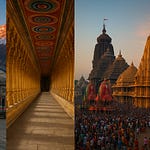The Somnath Jyotirlinga, known as Someshwar, stands majestically on the western coast of India in the Prabhas Patan region of Saurashtra, Gujarat. It is regarded as the first and foremost of the 12 Jyotirlingas of Lord Shiva, radiating eternal light, energy, and spiritual significance. The term Someshwar means "Lord of the Moon", symbolizing Shiva as the divine protector of Chandra Dev (Moon God).
📜 Origin & Mythological Foundation
The Legend of Soma and Shiva:
According to Shiv Purana, Chandra Dev (Moon God) was married to the 27 daughters of Daksha Prajapati, yet he favored Rohini among them. Angered by Chandra's favoritism, Daksha cursed him to lose his radiance and glow. Devastated and diminishing in power, Chandra came to Prabhas Kshetra and performed intense penance to appease Lord Shiva.
Pleased with his devotion, Shiva restored Chandra's brilliance, and hence came to be known as Somnath (Lord of the Moon). He also blessed the region to be a Tirtha Kshetra (sacred place), and thus Somnath became a powerful spiritual pilgrimage center.
📅 Timeline & Historical Journey
1. Ancient Foundations (Before 4th Century BCE):
Soma is believed to have originally constructed the temple in gold.
Ravana reconstructed it in silver.
Krishna rebuilt it in sandalwood.
Bhagwan Shree Krishna spent his final days in Prabhas Kshetra.
2. Maurya & Gupta Era (4th Century CE – 8th Century):
Somnath finds mention in accounts of Hiuen Tsang (Xuanzang) and ancient Sanskrit texts.
Flourished as a major center of Shaivism and pilgrimage.
3. Arab Invasions (10th–13th Century):
Repeated invasions and destructions by Mahmud of Ghazni in 1025 CE.
Temple plundered for its gold and wealth; destroyed multiple times by invaders including Alauddin Khilji’s army.
4. Mughal Era to Maratha Revival (13th–18th Century):
Continued destruction under Aurangzeb.
Sardar Vallabhbhai Patel envisioned its modern reconstruction after independence.
5. Modern Reconstruction (1947 onwards):
Present temple was reconstructed in Chalukya style in 1951.
Inaugurated by President Dr. Rajendra Prasad on May 11, 1951.
Managed by Shree Somnath Trust, established by leaders like Sardar Patel, K.M. Munshi, and Morarji Desai.
🛕 Architecture & Temple Complex
Chalukya Style of architecture.
Constructed from red sandstone, designed to withstand ocean winds and time.
The Shikhar (spire) rises to 155 feet.
Kalash (pot) atop weighs over 10 tonnes.
The Jyotirlinga is housed in the Garbhagriha, radiating peace and divine aura.
🔱 Spiritual & Religious Significance
First Jyotirlinga of the Dwadasha Jyotirlinga.
Believed to be the eternal shrine — never destroyed completely, symbolic of resilience and rebirth.
Closely associated with Lord Krishna's departure from Earth (Moksha Dham is nearby).
Gateway to Moksha for millions of devotees across ages.
🙏 Rituals & Worship
Daily Puja:
Abhishek Puja – Milk, curd, ghee, honey, and sugar used in Shiva Abhishek.
Rudra Abhishek – Recitation of Rudri while offering water on the Shivlinga.
Laghu Rudra & Maha Rudra – Special offerings on Shivratri and Mondays.
Naivedya – Traditional food offerings, bilva leaves, white flowers.
Special Days:
Maha Shivratri – Celebrated with grandeur; night-long vigils and bhajans.
Shravan Month – Thousands of devotees throng for Monday pujas.
🕯 Aarti Timings
Morning Aarti – 7:00 AM
Midday Aarti – 12:00 PM
Evening Aarti – 7:00 PM
(Subject to seasonal changes; check onsite or temple website.)
🧭 Travel & Visit Information
📍 Location:
Somnath, Veraval District, Gujarat
Lies on the western coast facing the Arabian Sea.
🚆 How to Reach:
By Train: Nearest station is Veraval (7 km).
By Air: Nearest airport is Diu (80 km) or Rajkot (190 km).
By Road: Well connected by buses and taxis from major cities in Gujarat.
🛏 Where to Stay:
Somnath Trust Guesthouses
Private hotels and dharamshalas nearby.
🗺 Nearby Places to Visit
Triveni Sangam – Confluence of Hiran, Kapila, and Saraswati Rivers.
Bhalka Tirth – Where Krishna was shot by a hunter.
Gita Mandir – Dedicated to teachings of Bhagavad Gita.
Prabhas Patan Museum – Displays ancient relics from the original Somnath temples.
Junagadh & Gir National Park – Nearby tourist and wildlife attractions.
🕉 Hidden and Lesser-Known Aspects
1. "Arrow Line" Inscription:
On the temple’s sea-facing wall, an inscription declares that there is no landmass between Somnath and the South Pole, showing the temple’s geodetic alignment with cosmic precision.
2. The Temple Bell:
Ancient lore speaks of a mystical bell that could ward off negative energies when rung during storms — currently lost to invasions.
3. Revival after 6 Destructions:
Somnath was destroyed and rebuilt at least six times, symbolizing undying faith and cultural perseverance.
4. Sapta Sindhu Association:
The temple is considered a gateway to the land of the Seven Rivers, the ancient cradle of Vedic civilization.
5. Divya Jyoti Stambha:
A pillar of light near the temple complex signifies Shiva as the eternal flame, known to be burning since ancient times.
🧘♂️ Devotee Experience & Spiritual Impact
Pilgrims and seekers speak of:
Instant emotional peace on stepping into the Garbhagriha.
Deep spiritual awakening during Abhishek rituals.
Transformational energy during Shivratri and Shravan visits.
Someshwar Jyotirlinga at Somnath is not just a sacred site — it is India’s eternal call to resilience, devotion, and spiritual power. A place where history meets divinity, and myth meets geography, Somnath continues to inspire generations.
It is said:
"When everything ends, Somnath begins again."
📌 Travel Tips
Best time to visit: October to March (cooler weather).
Language: Gujarati, Hindi, English.
Clothing: Modest temple attire (avoid shorts, sleeveless).
Photography: Not allowed inside the sanctum.










